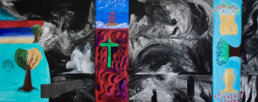The canvasSalvatore Garau - short notes on a painting born in prison
‘Freedom is a precious joy ‘, says one of the three inmates/painters who, inside the High Security Prison in Massama, Oristano, painted a large 200X500 cm canvas with me. In this simple statement you find all the meaning that revolves around the desire I had to share my freedom as an artist with those who have no freedom.
Banal to say, yet every day we are confronted with banalities that appear to be such, until an unforeseen event happens that makes you realise how little value you place on what you are convinced belongs to you by right. An accident, even a minor illness or a sudden lack of freedom, and you are forced to think about the treasure you had and never thanked for having. Yet it was not to be taken for granted.
Painting with boys who are not painters made me face an unexpected crisis. But the challenge of creating an important work, which was more than mere entertainment, had to be accepted. As the Canvas was gradually painted, the shyness, almost the anxiety, shown at first, melted away, and the three boys showed wonder at what they were creating.

The little of each united into a whole was going to show a story that, unbeknownst to them, revealed the intimacy of each of their lives. ‘I would like to paint a boat or a sailing ship; my father was a fisherman… ‘. Another simple sentence, said inside a prison, so rich in meaning that it needs no explanation. In short, the boys did a self-analysis without needing to ask for suggestions or help, a freedom that is really difficult to conquer gave them a tool to read themselves inside.
‘In front of this canvas you are freer than the free people outside, ‘ I told them. Such a statement could be frightening at first, but it was necessary to create in them the challenge. We know well how the lack of a trail, a sure path to follow, can create disorientation. Where do I go? To the right? To the north, to south? Deciding by taking full responsibility creates a sense of anxiety, even outside a prison. Tell me what you want me to do and I will do it: that ‘s definitely a more comfortable answer. That is why art is certainly the terrain of creativity par excellence, but it is also the place of the anxiety and challenge I mentioned.
The historical moment we are living in brought me back to the month I spent in prison. Certainly, some situations are related or very similar. For example, thinking becomes slower, settles down in a deep, introspective way, forces us to analyse areas of our ego held at bay by speed and therefore not even noticed, like when you can ‘t enjoy the landscape from the window of a car travelling at 200 kph. That same landscape on a bicycle is another planet rich in philosophy, history and biology.
Slowness, and the need for freedom that the virus has forced us into, could make us feel inadequate and slowly turn us off. Yet slowness should no longer be a poison but a medicine. After the month of painting, the three prisoners/painters had been reborn, overcoming an apathy to which they were forced by prison life. Every evening, as they returned to their cells, they had a new thought to nourish, a slow but expectant thought for the next day ‘s painting session.
It is up to us and us alone to make enforced seclusion productive. It is a time of true challenge with ourselves. Undeniably, it is a great struggle.
The surprising discoveries made by the boys during the project showed the power of art and speech inside sad places like prison. How much more powerful could art or simply a thought or a word prove to be inside our homes?